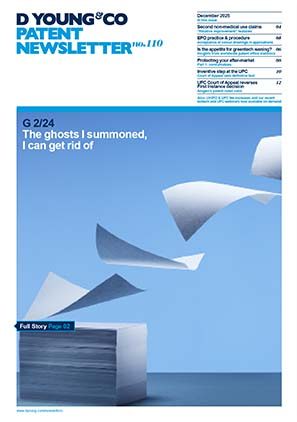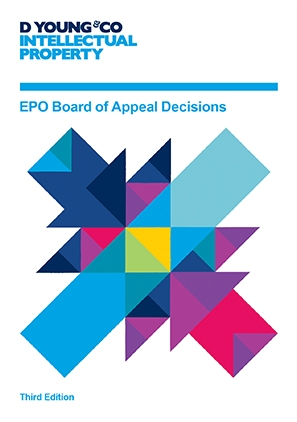G1/19: patenting computer simulation inventions
The EPO’s Enlarged Board of Appeal recently announced its decision in respect of G1/19, which relates to the patentability of computer simulation inventions. Simulation is a widely used tool in many fields of electronics, design and manufacturing, computer engineering, bioengineering, and chemistry to name but a few. Simulation is used to design products, understand and simplify complex processes, and is integrated into commercial and consumer technology. This decision therefore has far-reaching consequences across numerous fields of technology.
Background to G1/19
The application at issue concerned the modelling of “pedestrian behaviour” through a simulated environment (for example, a shopping centre or train station). Crucially, the claims did not contain either direct “input” from a real-world environment/building or “output” to the real-world, for example, using the modelling to inform a design of an environment/building.
The Technical Board of Appeal (T489/14), found that “a technical effect requires …a direct link with physical reality, such as a change in or measurement of a physical entity.” Accordingly, the Technical Board of Appeal found that modelling pedestrian behaviour through a simulated environment was non-technical and therefore excluded from patentability because it had no link with physical reality.
This, however, appeared to contradict the finding of T1227/05, in which the numerical simulation of a noise-affected circuit was considered to be technical. The Technical Board of Appeal noted that in both the present case and T1227/05, the inventions produced accurate and repeatable results and neither invention was any better suited to being carried out mentally. The Board of Appeal therefore intended to deviate from the interpretation of the EPC that was arrived at in T1227/05 and for that reason referred the following three questions to the Enlarged Board of Appeal which form the basis of G1/19:
- In the assessment of inventive step, can the computer-implemented simulation of a technical system or process solve a technical problem by producing a technical effect which goes beyond the simulation’s implementation on a computer, if the computer-implemented simulation is claimed as such?
- If the answer to the first question is yes, what are the relevant criteria for assessing whether a computer-implemented simulation claimed as such solves a technical problem? In particular, is it a sufficient condition that the simulation is based, at least in part, on technical principles underlying the simulated system or process?
- What are the answers to the first and second questions if the computer-implemented simulation is claimed as part of a design process, in particular for verifying a design?
Admissibility
When answering the referred questions, the Enlarged Board of Appeal first considered their admissibility. While the Enlarged Board of Appeal was satisfied with the admissibility of the first and third questions it took exception to the second question.
The Enlarged Board of Appeal considered that question 2 should be separated into its two sub-questions, labelling the first sub-question as question 2A and the second sub-question as question 2B.
In respect of question 2A “If the answer to the first question is yes, what are the relevant criteria for assessing whether a computer-implemented simulation claimed as such solves a technical problem?” the Enlarged Board of Appeal considered that in view of current EPO practice in this area (as defined in COMVIK), and the presence of question 2B, question 2A exceeded the “real need for clarification” and therefore found it to be inadmissible.
In contrast, the Enlarged Board of Appeal admitted question 2B “In particular, is it a sufficient condition that the simulation is based, at least in part, on technical principles underlying the simulated system or process?” stating that this question was both sufficiently specific and, in its assessment, would provide helpful guidance.
Answers
A first key theme throughout the decision was the Enlarged Board of Appeal’s approval of the COMVIK case law, which informs current EPO practice in the field of computer-implemented inventions. COMVIK states that features that do not contribute to the technical character of the invention should be disregarded when determining the technical effect for the purposes of inventive step when using problem/solution.
In answering the questions, the Enlarged Board of Appeal largely endorsed this pre-existing case law, although, as discussed elsewhere in this article, specific elements of the Enlarged Board of Appeal’s reasoning provide key guidance and practice points for applicants patenting in this area.
A second key theme of the decision is that one should “assess things on a case-by-case basis”. Not only is this spelled out in several of the Enlarged Board of Appeal’s reasons given for its answers, but is also essentially their reasoning behind their refusal to answer question 2A.
The Enlarged Board of Appeal answered the questions as follows:
Question 1: A computer-implemented simulation of a technical system or process that is claimed as such can, for the purpose of assessing inventive step, solve a technical problem by producing a technical effect going beyond the simulation’s implementation on a computer because (paragraph 139): “No group of computer-implemented inventions can be a priori excluded from patent protection”.
Question 2[B]: For that assessment it is not a sufficient condition that the simulation is based, in whole or in part, on technical principles underlying the simulated system or process because (paragraph 141): there is no legal basis for “computer-implemented simulations [to] hold a privileged position within the wider group of computer-implemented inventions”. The Board of Appeal also noted that not only is this feature not sufficient but also (paragraph 142) it is not necessary.
Question 3: The answers to the first and second questions are no different if the computer-implemented simulation is claimed as part of a design process, in particular for verifying the design because (paragraph 144): there is not “any need for the application of special rules if a simulation is claimed as part of a design process”.
Guidance from the Enlarged Board of Appeal - routes for inventiveness
The Enlarged Board of Appeal confirmed that there are, in principle, a number of different routes by which a simulation invention may provide a technical contribution.
- A first route is if the simulation is particularly adapted to the computer or its functioning, for example through the division of aspects of a calculation across specific hardware components. Applicants should question whether the simulation is particularly well suited to operating on specific underlying hardware architectures. One example given by the Enlarged Board of Appeal is a simulation that requires execution on a quantum computer, which might therefore have to be designed in a particular way. Underlying software considerations could also be decisive, provided the software considerations relate to the low-level functioning of the computer, as opposed to application-level software. If a simulation has been created based on these kinds of considerations, then applicants could be in a good position regarding patentability.
- A second route is where the output of the simulation “form[s] the basis for a further technical use of the outcomes of the simulation (e.g. a use having an impact on physical reality)”. For instance, a hardware device could be controlled based on the results of the simulation. Whether or not this feature needs to be specified in the claims, however, is a further complication (see below).
- A third route is how inputs to the simulation are obtained. In particular, the Enlarged Board acknowledged (paragraph 99) that measurements are generally considered to have technical character. Of course, the regular hurdles of inventive step must still be overcome. In particular, a system that does nothing but take measurements using known systems and inputs those values into a known simulator is unlikely to be inventive.
- A fourth route may exist in the underlying real-world system that is being simulated if that system is technical. For instance, a drill bit is a physical real-world device and therefore technical. The simulation of the performance of a drill bit could therefore be technical. However, the Enlarged Board noted that a system being simulated is often prior art. Consequently, merely simulating (using standard techniques) a known system is unlikely to itself be patentable.
Guidance from the Enlarged Board of Appeal - implicit technical effects in “pure” simulations
Interestingly, with regard to the second route, the Enlarged Board of Appeal confirmed that this “further technical effect” output need not be explicitly set out in the claim and that in principle claims to pure simulations without a real-world application of an output could be patentable. It did, however, state that “only in exceptional cases may such calculated effect be considered implied technical effects (for example, if the potential use of such data is limited to technical purposes […])”. The Enlarged Board of Appeal has therefore made clear its view that if the results of the simulation have a variety of purposes then those results cannot contribute to inventive step. The reasoning given is that under the analysis of inventive step the claim would not produce the technical effect over substantially the whole scope of the claim and so a technical effect cannot be acknowledged. In other words, implied further technical effects resulting from output data would normally only lead to a claim being found inventive “if the potential use of such data is limited to technical purposes”.
Guidance from the Enlarged Board of Appeal - simulation quality
While the Enlarged Board of Appeal found that the accuracy of the simulation did not matter per se when considering whether technical character existed it noted that accuracy must exist to the extent that the further technical effect can be achieved (paragraph 111).
The Enlarged Board of Appeal also noted that simulation accuracy or speed could lead to a technical effect. For instance, if simulation accuracy now makes it possible to do something that was not previously possible then a technical effect could arise. Similarly, a technical effect could arise if the invention leads to a simulation being performed sufficiently quickly that it can be used in a time-critical system, for instance.
Implications - AI and machine learning
At a high level, machine learning techniques involve the use of algorithms to learn specific behaviours. These techniques find uses in a wide range of subject areas including product design, testing and implementation. In some cases, AI can be said to be carrying out a type of simulation (albeit, possibly one in which the underlying physical system is either not explained/represented or might even be impossible to explain/represent).
As machine learning is widely used in the design of products and is implemented with specific purpose within commercialised end products, the potential to gain patent protection of such simulations may be of interest to companies employing AI in their design process or products.
This decision suggests that the use of machine learning to produce a design or other output, where the output is limited to a technical purpose, may be patentable. What is perhaps less clear is whether the machine learning algorithms themselves would be considered by the EPO to reflect the physical behaviour of a system and whether, in the broadest sense, the generic use of a new machine learning algorithm would be considered as being limited to technical purposes.
Implications - cross-jurisdiction considerations
Simulation of a physical system is highly portable, particularly for claims which do not require the actual use of a simulated result, and a simulation protected in one jurisdiction could be run on a server or high-performance computing cluster available in a different jurisdiction where the patent is not in force.
Patent protection for a process extends to cover products obtained via that process. However, where the product that is obtained is a design or a parameter based on a simulation that is carried out outside of the protected jurisdiction, proving that the design or parameter was obtained via the protected process, and not independently via a different method, may prove challenging. Furthermore, once the design or parameter is known, a person wishing to use the parameter could conduct a standard design process, albeit biased by the knowledge of the design or parameter, and arrive at the known result.
For example, if the protected process is the fabrication of a particular circuit based on a netlist, the production of a netlist itself would not constitute direct infringement of the patent. Rather, the infringement would be the fabrication itself which is typically carried out by a smaller number of chip manufacturers who may not be in a position to determine whether the fabrication of a particular integrated circuit would constitute infringement.
On the other hand, it is clearly more difficult to avoid infringement of a claim that does not require the actual use of a simulated result. For example, a claim directed towards the simulations of a structure for a particular type of drug would be infringed regardless as to whether the particular drug was actually produced. Had the actual production of the end product been required to infringe, this process could have been carried out in a different jurisdiction resulting in the simulation only constituting contributory infringement.
These questions of infringement are for national courts to decide. However as discussed, this decision provides a number of routes for patentability and offers the potential for an increased scope of protection for simulation claims and potentially paves the way for further developments in this area.





